As an Amazon Associate I earn from qualifying purchases.
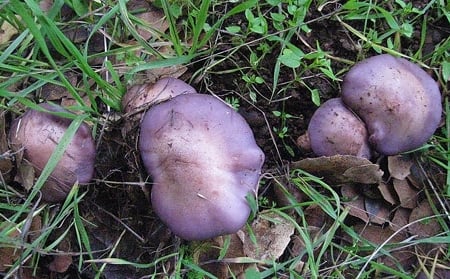
I present to you Lepista nuda, also known by the homey name blewit, which sounds like you just missed a great opportunity. And you would, if you passed up a chance to eat these mushrooms.
Blewits are a worldwide species (also known as Clitocybe nuda, with a cousin Lepista saeva in Europe) that likes trees and fallen leaves or other decomposing duff. It is pretty easy to identify and worth taking home, if only for the vivid lilac-to-lavender color.
I mentioned a few weeks ago that I walked right by some blewits on a recent mushroom foray. Yes, I “blewit.” But I made amends by returning to that spot a week later, where I picked 2 pounds in 15 minutes. I also found some blewits near Folsom Lake two days ago, so they are popping now.
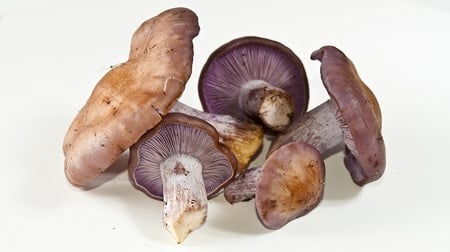
Here’s what you need to know about gathering blewits:
- They are, in general, a cool weather mushroom, arriving in the Northeast and Pacific Coast around October and persisting all winter long — so long as there are no extended frosts.
- Blewits have a standard “mushroom” shape: simple cap, a thick, stocky stalk, tight gills. There will be no ring or veil around the stalk.
- The cap should be smooth, almost suede-like. It will have leaf litter stuck to it from time to time, but it will never be slimy or viscid. Blewit caps are often beige to mauve. As the mushroom ages, the edges of the cap will get wavy.
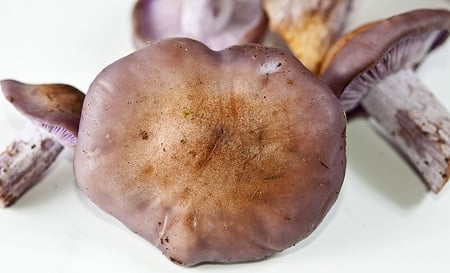
- Look for the lilac or lavender color underneath the cap. The color on a blewit is concentrated on the gills, although the cap and stalk will be a little purple, too. The gills are close together.
- Blewits like company, both their own and with other mushrooms. It is rare to find just one blewit, and they will often pop up in loose arcs or rings. Chanterelles are often around them, too.
- Here in California they seem to like to hang around oaks. But they can grow in any pile of decomposing stuff. Blewits will return year after year in the same spot if there is a fresh supply of litter, mostly fallen leaves.
- When you do a spore print — cut the cap off a mushroom and place it, gills down, on a white piece of paper — the spores should light in color, a whitish dull pink to pinkish beige. Their poisonous lookalike, the Cortinarius, has darker, rusty-colored spores.
- Blewits have a slight aroma, which I think smells like lilacs. David Arora in Mushrooms Demystified says they smell like frozen orange juice.
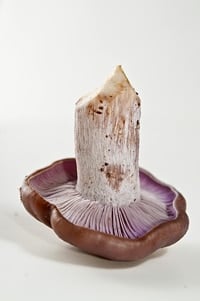
There are a few other blue-to-purple mushrooms around, but none that meet all these requirements. If you have a mushrooms with a suede-like cap, stocky stalk, tight, vivid purple gills, a slight but pleasant aroma and that has light, pinkish-tan spores, you have a blewit.
Just keep an eye out for purple mushrooms with “cobwebs” around the veil of the cap — those are cortinarius, which are mostly a toxic species.
Sadly blewits don’t merit the praise and adulation that chanterelles, porcini or morels do. I found no author who detailed the pluses and minuses of particular cooking methods, and only hints at what other foods go well with blewits. Shallots, butter and cream for certain. One author says they like anise flavors, like Pernod or fennel. Another says they don’t like garlic.
The one recipe I did find repeated in various ways was, of all things, an English one; the English are notoriously fungi-phobic. Yet I found lots of versions of a blewit and chicken pot pie. Sounded good to me.
Only I did not want to bother with a pie crust, and I thought I might sex up the standard recipe with some French touches: thyme, shallots and Armagnac. I also skipped the chicken and went right for some pheasant breasts I had in the freezer.
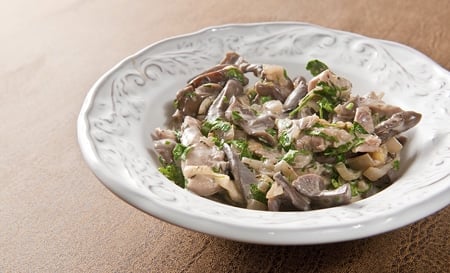
First thing I noticed is that blewits act a lot like the common cremini or button mushrooms you get in the store. They are thick, firm and full of water, which must be dry-cooked away before adding butter or oil. This is actually a good thing, because if you are not a mushroom hunter, you can easily substitute button mushrooms for blewits.
As a side note, the only thing you cannot do with blewits that you can with button mushrooms is eat them raw: Most sources say you must cook blewits before eating them. You won’t die if you eat raw blewits, but you will probably throw up and feel generally ill.
The second thing I noticed while cooking blewits was that despite what several authors say, they do not retain that lilac color when cooked. Or at least they didn’t after I dry cooked and then stewed them. Maybe they might keep the color if I gently steamed the mushrooms.
Third thing was in the eating. Blewits taste good enough — pretty standard mushroom flavor — but they can be a little slippery in texture. Not nasty-slimy-okra-slimy, just a little slippery. Took four or five bites to get used to it.
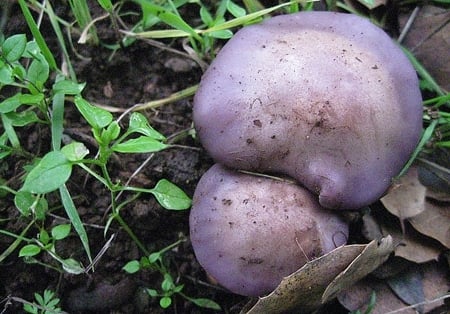
On the plus side, blewits are firm and chewy in a good way. It’s that squeaky, almost crunchy texture that you either love or hate with mushrooms. They can definitely stand on their own in a vegetarian dish, if you so desire.
For me, I loved the play between the texture of the mushrooms and the meaty pheasant breast, which is just gently cooked in cream and pheasant stock. And of course the butter, brandy, cream and shallots didn’t hurt, either. I’d make the recipe for blewit and pheasant again, and, if I chopped everything up small, I might even put it in a pie.

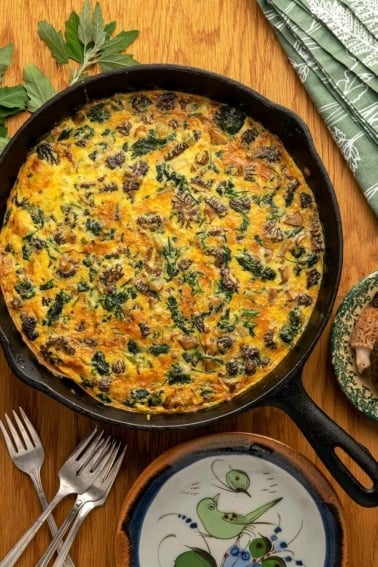
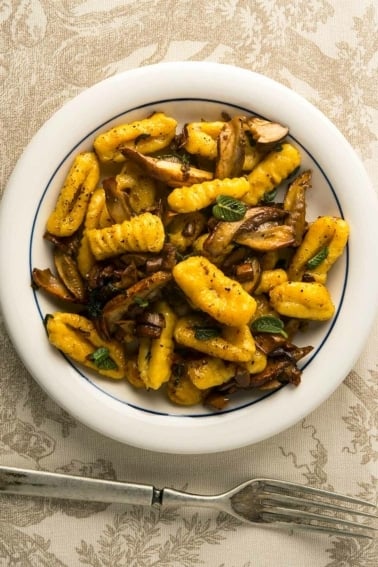

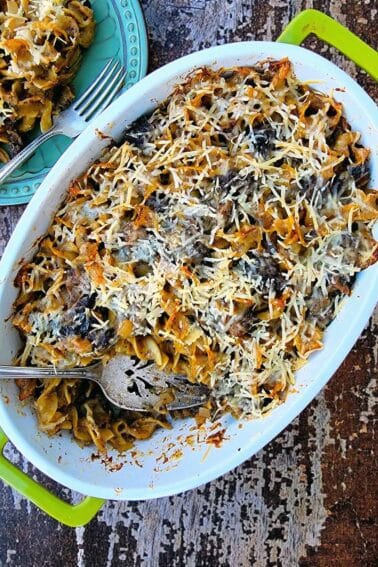
Just found Blewit mushrooms for the first time. I went online looking to confirm identification and a recipe, and came across Hunter Gather Cook.
Thank you for sharing.
I found you on Instagram also and saw a recent hunt you went on in Oklahoma- near my hometown, Lawton. Lss, my Brother lives in Mayer, MN and recently made that 13 hour drive to SW Ok 🙂
I live in Northern Virginia. I found the slender-stalk blewits (Lepista sordida) growing in groups near a very old black walnut tree in my yard. There wasn’t a traditional abundance of leaf litter, but there was grassy mulch and old shallow roots of the black walnut. It was a cool morning in early October, and they had just popped up, so the caps weren’t completely flat yet; they were very lilac in color. To me, the fragrance was a kind of lilac-jasmine. I sauteed the caps with onions in coconut oil, and made a coconut milk cream sauce, pouring it over shredded white meat chicken/basmati rice, with a bit of toasted black walnuts (which are also mild in flavor). Because of their delicate scent and flavor, I thought it best to stay with other delicate seasonings…it was absolutely delicious! and because the coconut oil heats at a lower temperature, the bluish color remained, it didn’t turn dark brown. I highly recommend using coconut or black walnut flavors with blewits, as a nice mushroom flavor was still detectable.
I just discovered a whole bunch of domed, light tan to almost cream colored, thick stemmed etc. mushrooms growing on a quite old white oak leaf pile, that after studying all I can find, I believe they are edible Blewits but I’m shy to try them in case I’m describing a toxic mushroom. It is early October here in northwest Wisconsin. How might I send you pictures to solidly identify them?
Do you ever dehydrate blewits?
Wayne: Yes, but rarely.
I am a Nigerian and just woke up after dreaming of collecting purple coloured mushrooms. Pls can you give me the medicinal value of this mushrooms?
Thank you
Osaigbokan: None. Sorry to disappoint you. And they don’t stay purple when cooked.
I’m pretty sure almost all mushrooms have immune system boosting properties? correct me if I’m wrong.
Daniel: I can’t help you there, sorry. I just eat them because they are tasty.
I have just discovered several patches of blewits in a mulch/leaf covered area in my yard. A friend who is an expert identified them for me. However, mine do not have a bluish or lavender appearance, but meet all the other criteria. I am wondering if the color changes based on time of year, temperatures or conditions. I am in northwestern North Carolina. The patches were discovered January 2, 2020, and I have been enjoying them sauteed in olive oil, with garlic and onions. Thanks so much!
Yes, the color and appearance of the blewit changes pretty drastically, even from day to day. The mature versions of the mushroom look very different, than the button stage. When young, blewits tend to show their purplish lilac coloration as described above, especially under the cap. As they age however, the cap opens and flattens out, they significantly grow in size as you might expect. The color of the top surface of the cap and the stem changes from purplish to light tan. The blewit always maintains it’s light-colored spore print, and no remnants of a cobwebby veil that once covered the gills.
Blewits make a fabulous cream of mushroom soup. I like them for their flavor and texture, but also because they come at a time of year when the other mushrooms have usually disappeared. We find blewits in late Oct through Nov in Michigan. If you don’t find them in the woods, check around your compost pile. We often find them there, and sometimes right in the garden!
I just break them into pieces and stew them in slightly salted water in a pan on the stove top or in a casserole dish in the oven with enough water to cover them. When cooked, thicken the cooking water with a little flour.
Delicious with bacon and egg and some nice bread for breakfast.
One of my favourites, I really like their meaty texture.
Reckon the blewits don’t grow in North Carolina… But I think y’all don’t know there are ways to cook okra that aren’t slimy… 🙂 especially the way I do. I do enjoy your articles and letters. The one about the boerewors was somer lekker. I lived in RSA a long time ago.
They definitely do live in NC! Found them with a mushroom class in the botanical gardens in Chapel Hill, and my own backyard in Carrboro.
I love of them more than any other mushroom! I have found they go perfect with goat and lamb dishes. Just saute them with a tad of seasoned juice from the pan
With venison I use mediteranian spices like cinnomon allspice a touch of coriander
With lamb mint and garlic onions shallots saute in olive oil never butter
For me I cook outside on wood with only a grate. Over the coals cast iron pans a must
Try adding a table spoon of Greek yogurt with chives and fresh chopped mint and a few tablespoons of meat juice from the pan to them salute. Just till soft then spoon over a forager salad and the main meat dish
This made me starving lolol
Gently fried them in butter, and made this a cream sauce for ricotta raviolli. Yum! They did mostly retain their purple color. It’s a delicate flavor, and it would be easy to overpower them with too much cooking or seasoning.
I just like to fry mine in a bit of bacon grease. Salt and pepper. Sometimes I will add a bit of mild onion and fresh red pepper and – yes – a bit of garlic.
October, Dells, WI.
Picked a bunch of Blewits, the first I’ve found in USA. The smell took me back to UK where as a teen I picked thousands of them in the forests from Epping to Wanstead. The reason you HAVE to cook them is because they contain a “Therlolabile Haemolitic poison”. For those who don’t speak geek, a haemo;ite destroys blood cells, while thermolabile (as opposed to thermstabile) is destroyed by heat.
I’ve done a short soak in a marinade of soy sauce, olive oil, garlic, salt and pepper and grilled them. Serve as a first course, side dish or on an antipasti platter.
I just picked so blewits today where I work under an oak. The OJ smell is strong , the spore color is almost full white, no veil, the only thing is the caps are not radiating purple, the gills are light lavender and flesh is lighter but the same. Don’t know what else they could be, it certainly seems like the real deal.